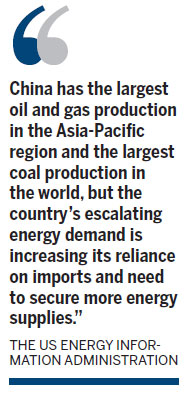China's oil demand is growing, US agency says
Updated: 2014-02-06 12:52
By Michael Barris in New York (China Daily USA)
|
||||||||
China's escalating energy demand is increasing its reliance on oil imports despite the nation's effort to control fossil-fuel consumption, according to a report from the US Energy Information Administration (EIA).
The independent statistical agency within the Department of Energy said it expects China to import more than 66 percent of its total oil by 2012 and 72 percent by 2040 "as demand is expected to grow faster than domestic crude supply".
The State Council's 12th Five-Year Plan for energy development, published early last year, included a measure to cap oil imports at 61 percent by the end of 2015. The aim was to limit dependence on fossil fuels while developing cleaner burning fuels to protect the environment after more than three decades of rapid economic growth. The 61 percent cap was an increase from 2012, when China imported 57 percent of its crude-oil needs.
Oil, China's second-largest energy source, accounted for 18 percent of total energy consumption in 2011, according to the EIA. Coal, overwhelmingly the top source, supplied 69 percent.
"China has the largest oil and gas production in the Asia-Pacific region and the largest coal production in the world, but the country's escalating energy demand is increasing its reliance on imports and need to secure more energy supplies," the EIA said in a statement Wednesday.
China is the world's second-largest oil consumer after the US and became the largest global energy consumer in 2010. A net oil exporter until the early 1990s, it became the world's second-largest net importer of crude oil and petroleum products in 2009.
In last year's fourth quarter, China actually became the largest global net importer of oil. The EIA projects China is likely to surpass the US in net oil imports on an annual basis by 2014 as US oil production and Chinese oil demand "increase simultaneously".

The EIA forecasts that China's oil consumption will continue growing at a "moderate pace" through 2014 to approximately 11.1 million barrels per day, and its net oil imports will reach 6.6 million bbl/d, 20 percent more than the US's 5.5 million bbl/d.
China's rising oil consumption - the nation accounted for one-third of the world total last year, a feat it is expected to duplicate in 2014, - came despite its cooling economic growth. As the nation embraced an economic model built mainly on consumption and services and began to turn away from exports and investment, its gross domestic product growth slowed to an estimated 7.7 percent in both 2012 and 2013, after averaging 10 percent from 2000 to 2011, according to the International Monetary Fund.
Although China has tried to diversify its energy supplies, the results have been modest, with alternative energy sources capturing relatively small shares of the country's energy market. Hydroelectricity has a 6 percent share, followed by natural gas (4 percent), nuclear power (nearly 1 percent) and other renewable fuels (1 percent), according to the report.
China's increasing dependence on oil imports, combined with Chinese companies' need to develop expertise in managing other energy sources and the country's oil and gas exploration and production activities are driving its national oil companies to invest in international projects and form partnerships with global oil companies, according to the report.
The Middle East remains China's largest source of crude oil imports, supplying 2.9 million bbl/d, or 52 percent, last year, according to the report.
In 2012, China reduced imports from Iran, historically its third largest exporter, by 20 percent owing to a contract dispute between Sinopec, China's key oil importer, and Iran's state company. Iran subsequently fell to sixth in crude oil exports to China, trailing Saudi Arabia, Angola, Oman, Russia and Iraq. It provided 8 percent of China's crude oil imports in 2012 and 2013, down from 11 percent in 2011, according to the report.
The Iran contract dispute was settled by mid-2012, but China reduced its average oil import levels from the country to "maintain diplomatic ties with the United States and Europe as a result of global sanctions imposed regarding Iranian crude oil sales over disagreements on Iran's nuclear program," the report said.
Although natural gas production and use is rapidly increasing in China, the report said the fuel made up only 4 percent of total primary energy consumption in the country in 2011. The government has said it wants natural gas to account for 8 percent of total energy consumption by the end of 2015 and 10 percent by 2020 to combat severe air pollution resulting from the country's heavy reliance on coal.
As the world's largest coal producer and consumer, China leads the world in producing carbon dioxide emissions. The government's aim is to reduce carbon emissions per unit of GDP by 17 percent between 2010 and 2015 and energy use per unit of GDP by 16 percent during the same period. It also intends to cut overall carbon dioxide emissions by at least 40 percent between 2005 and 2020.
Under the Five-Year Plan, coal use would be capped to below 65 percent of total primary energy consumption by 2017 to reduce air pollution and choking smog that has afflicted Beijing and other areas of the country in recent years.
michaelbarris@chinadailyusa.com
(China Daily USA 02/06/2014 page1)

 Chinese Lunar New Year gift from abroad
Chinese Lunar New Year gift from abroad
 Koreas reach out for family reunions
Koreas reach out for family reunions
 Storm to slam two-thirds of US
Storm to slam two-thirds of US
 Clowns gather for Joseph Grimaldi celebration
Clowns gather for Joseph Grimaldi celebration
 Thai caretaker PM urges protesters not to block voting
Thai caretaker PM urges protesters not to block voting
 Holy waters in Nepal
Holy waters in Nepal
 Kongfu stars wax shine in London ChinaTown
Kongfu stars wax shine in London ChinaTown
 Obama pushes minimum wage hike
Obama pushes minimum wage hike
Most Viewed
Editor's Picks

|

|

|

|

|

|
Today's Top News
Flying Tigers denounce Abe's visit
Schroeder accuses US of disrespect
US warns airlines about 'toothpaste bombs'
Xi leaves for Sochi ceremony Thursday
China's oil demand is growing
US criticism over ADIZ unfounded
Murderer of China students sentenced
China reports 11 H7N9 cases
US Weekly

|

|





